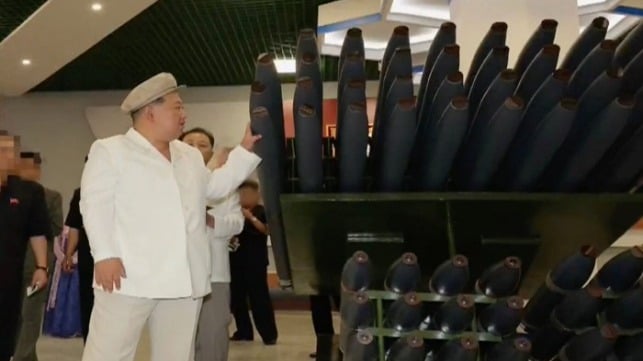North Korean Missile Shipments to Russia Continue, but May Have Peaked

North Korean exports of artillery ammunition to Russia, for use in its war against Ukraine continue. But volumes shipped in recent weeks have fallen back from previous peaks, suggesting that initial consignments may have come from stockpiles, now depleted, with more now being met directly from production.
The traffic between North Korea and Russia has been tracked by the Open Source Centre (OSC), led by James Byrne, formerly Director Open Source Analysis at the UK’s Royal United Services Institute for Defence and Security Studies. North Korean ammunition is shipped in containers from Raijin to the Russian ports of Danube and Vostochny in the Vladivostok area. By monitoring the four Russian flagged RO-RO container ships carrying the containers - MV Angara (IMO 9179842), Lady Mariia (IMO 9220641), Maya-1 (IMO 9358010) and Lady R (IMO 9161003) - then counting the containers on board and measuring volumes, OSC has been able to accurately gauge the number of artillery shells being shipped. All four of the Russian ships are US-sanctioned, and several have also been used for hauling military cargoes to and from Tartus in Syria.
MV Maya-1 has recently come off the Sea of Japan route, loaded cargo in China, transited the Suez Canal in February and conducted a turn-round in Kaliningrad, leaving on April 10 for an unknown destination. It has apparently been unimpeded whilst in transit or during its port calls, despite being sanctioned.
OSC tracked 64 trips by the four Russian ships between September 2023 and March 2025. Traffic peaked in January 2024, when seven cargoes were shipped. By March 2025, only three cargoes per month were being shipped. Over the entire period, the 64 sailings sighted shipped a calculated 15,809 containers, with each container likely to have held 224 boxes of 152mm artillery shells, or other loads made up of rockets, 122mm or mortar rounds. Using these figures, OSC estimates that up to 6 million shells might have been shipped to Russia by North Korea by the end of March 2025.
Once unloaded at the Russian ports, the containers are moved by train directly to Russia ammunition depots servicing the Ukrainian front line. The main receiving depot at Tikhoretsk, 60 miles south of Rostov, was attacked by Ukrainian drones on September 21, 2024, with an estimated 90% of the stockpile destroyed. In 2025, Ukraine is planning on producing 3000 of its own-design Bars, Peklo and R-360 Neptune missiles, the latter of which has a range of more than 600 miles, and all of which are capable of attacking Moscow
Ukrainian defense intelligence estimates that North Korea is providing half of the ammunition currently being consumed on the Ukrainian front line. Batches of the Korean ammunition have to be proofed and separate range tables drawn up, as the performance of the Korean ammunition is inconsistent and inferior to Russia’s own production. The North Korean shells are also prone to exploding in the breach, if loaded into barrels which are hot from high intensity fire missions.
Russia is also known to receive shipments of 122mm and 152mm ammunition shells from Iran, albeit in lesser volumes. Iranian exports have tended more towards the supply of drones and missiles. Iran ships weapons through the Caspian ports of Bandar-e Anzali and Amirabad to either Kaspiysk in Dagestan or the Volga-Don trans-shipment port at Olaya. On January 2 this year, Iranian social media images showed Iranian air defense and truck-mounted Fath-360 tactical ballistic missile systems (comparable in capability to the M142 HIMARS) at the dockside at Bandar-e Anzali prior to loading.
